Cubitus Valgus Deformity
Table of Contents
What is a Cubitus Valgus Deformity?
- Cubitus valgus is a medical deformity in which the forearm is angled away from the body to a greater degree than normal when fully extended. A small degree of cubitus valgus (known as the carrying angle) is acceptable and occurs in the general population.
- When present at birth, it can be an indication of Turner syndrome or Noonan syndrome. It can also be acquired through fracture or other trauma. The physiological cubitus valgus varies from 3° to 29°. Women usually have a more pronounced Cubitus valgus than men. The deformity can also occur as a complication of fracture of the lateral condyle of the humerus, which may lead to tardy/delayed ulnar nerve palsy. The opposite condition is cubitus varus.
- Cubitus valgus is a deformity in which the forearm is angled out away from the body when the arm is fully extended. When it affects both arms, it’s known as cubitus valgus bilateral.
- When your palm is facing upward and your arm is extended, you may have cubitus valgus if your carrying angle, or the degree to which your arm is angling away from your body, exceeds 15 degrees.
- However, it’s possible to be diagnosed with cubitus valgus with a carrying angle anywhere between 3 and 29 degrees. The angle is often more pronounced in women.
- This condition doesn’t always need to be treated, but in some people, it can compress the nerves in the arm, causing complications.
- Carrying angle is a small degree of cubitus valgus, formed between the axis of a radially deviated forearm and the axis of the humerus. It helps the arms to swing without hitting the hips while walking. In full flexion these axes become aligned.
- Normally it is 14° (female) and
- 11° (male) away from the body.
- A decreased carrying angle can result in the forearm pointing towards the body, known as gunstock deformity or cubitus varus.
Defination
- Cubitus valgus: A deformity of the elbow resulting in an increased carrying angle (so that, with the arm extended at the side and the palm facing forward, the forearm and hand are held at greater than 15 degrees). Cubitus valgus can be due to a congenital malformation, as in Turner syndrome and Noonan syndrome, or be due to a fracture. Cubitus is the Latin word for elbow and valgus means angled outward.
Symptoms
- Visible defect cosmetic
- Limited Elbow Range of Motion
- Rarely Elbow Pain
- Muscle Weakness
- Growth Plate Irregularities
- Secondary tardy nerve palsy
Causes
- Previous fracture of lower end of humerus or capitulum with malunion.
- Interference with epiphyseal growth on lateral side from injury or infection.
There are mainly two causes for cubitus valgus:
1) congenital condition
2) fractures
Two congenital conditions:
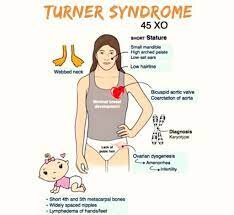
1)Turner syndrome: Turner syndrome is a chromosomal disorder in which a female is born with only one X chromosome. People with Turner syndrome experience a number of other symptoms, including short stature and delayed puberty. Treatment usually involves hormone replacement therapy.
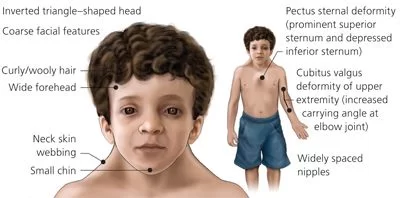
2) Noonan syndrome: Noonan syndrome is another genetic disorder that results in delayed development. It’s usually caused by a genetic mutation, but sometimes doctors aren’t sure why it develops. While there’s no cure for Noonan syndrome, there are a number of treatments that can help minimize its effects.
Complications
- Seen as a complication of fracture of lateral condyle of humerus.
- Cubitus valgus is a known cause of ulnar neuropathy. This is a disorder involving the ulnar nerve, which is one of the three main nerves in your arm.
- Ulnar neuropathy most often occurs when the ulnar nerve becomes compressed or irritated, causing numbness, tingling, and occasionally weakness. Most of the time treatment involves limiting physical activity and wearing a brace. However, if these conservative treatments don’t work, surgery may be necessary.
- Cubitus valgus can also lead to a condition called tardy ulnar nerve palsy, a type of ulnar neuropathy. This is a chronic condition that is commonly associated with cubitus valgus.
- Ulnar nerve palsy is progressive, in that it usually gets worse over time. You may experience a loss of sensation in your fingers, especially your ring and little finger, as well as loss of coordination, tingling and burning, pain, and weakness.
- There are a number of treatments for the symptoms of ulnar nerve palsy, including over-the-counter medications and physical therapy.
Treatment of Cubitus valgus
If cubitus valgus isn’t compressing your ulnar nerve, you probably won’t need treatment.
In most cases, cubitus valgus is treated by one of two procedures:
1) osteotomy or
2) fixation.
- Osteotomy is a process in which your doctor cuts the bone in order to reshape it, thereby changing its alignment.
- A particular type of osteotomy called distraction osteogenesis has been used to treat cubitus valgus in children. This operation works by making a longer bone out of a shorter one. The bone that is cut during surgery is pulled apart using a device called a distractor, a process that is only mildly painful. New bone will grow in the gap created by the distractor, creating a longer bone in place of a shorter one.
- Fixation is the process by which your doctor will reconnect the bones of the elbow, usually following a fracture.
PHYSIOTHERAPY TREATMENT:
- Background: Physiotherapeutic intervention in a phasic manner has been in practice after orthopedic surgeries .graded physiotherapy has a great value in reducing post surgical inflammation pain and improving mobility. this work is done towards presenting the data regarding post surgical condition of corrective osteotomy for cubital varus on left side the treatment techniques were chosen on the basis of phasic evaluation and post treatment evaluation was done in order to check the prognosis in terms of inflammation, pain and ROM .several exercise therapeutic techniques and electro therapeutic techniques have been selected periodically on a basis of pre- treatment assessment. In this data presentation electro therapeutic techniques like, faradism under tension for correction of deformity, TENS, ULTRASOUND, PARAFFIN WAX BATH (pain relief and extensibility) where the treatment modalities selected.
- Method: Treatment techniques were selected based on the evaluation in every particular session. . faradism under tension, Paraffin wax bath, TENS, muscle energy techniques, cyriax deep friction massage and ultrasound therapy modalities were used selectively.
- Results: Faradism under tension, Paraffin wax bath, TENS, muscle energy techniques, cyriax deep friction massage and ultrasound therapy modalities were used selectively with range of movement exercise in four phases and evaluation was done in every session. each phase was of 3 days at the end of 12 days re evaluation was done and found that there was a marked decrease in pain, inflammation and increased range of motion.
- Conclusion: after the selective physiotherapy approaches there was reduction of pain,oedema and range of motion was improved. graded physio therapeutic intervention is important to most of the orthopedic post operative conditions in reducing pain, decreasing inflammation, increasing mobility.
- Keywords: CYRIAX deep friction massage, faradism under tension, muscle energy techniques.
- TOOLS: Inch tape, goniometer
FAQs
A malformation of the elbow joint is referred to as cubitus valgus in healthcare. When someone has cubitus valgus, the ulna, which is the forearm bone, deviates from the humerus, which is the upper arm bone, increasing the angle at the elbow joint. When the arm is completely extended, this deviation causes the forearm to “bow out” away from the torso.
Cubitus valgus may result from a fracture or from a congenital disease. Turner syndrome and Noonan syndrome are the two congenital disorders most frequently responsible for cubitus valgus. When a female is born with only one X chromosome, it is known as Turner syndrome.
Without reducing elbow range of motion, Milch osteotomy is a successful treatment for correcting cubitus valgus deformity and its related delayed ulnar nerve palsy. The problems caused by the ulnar nerve are likely to become better with even severe valgus deformities corrected without concurrent anterior transposition of the nerve.
As a result, the elbow turns outward from the body. Cubitus Valgus can lead to an obvious deformity as well as pain and difficulties doing tasks like lifting or throwing.
All patients can be treated successfully with Milch osteotomy with secure fixation utilising plates and screws to rectify cubitus valgus deformity caused by lateral humeral condyle fracture.
Cubitus valgus, however, can be identified with a carrying angle of any value between 3 and 29 degrees. In women, the angle is frequently more obvious. Although this medical condition isn’t often serious, in some persons it can compress the arm’s nerves and lead to problems.

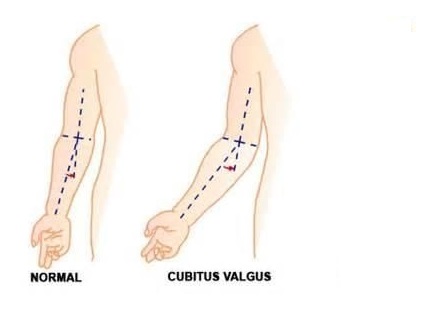
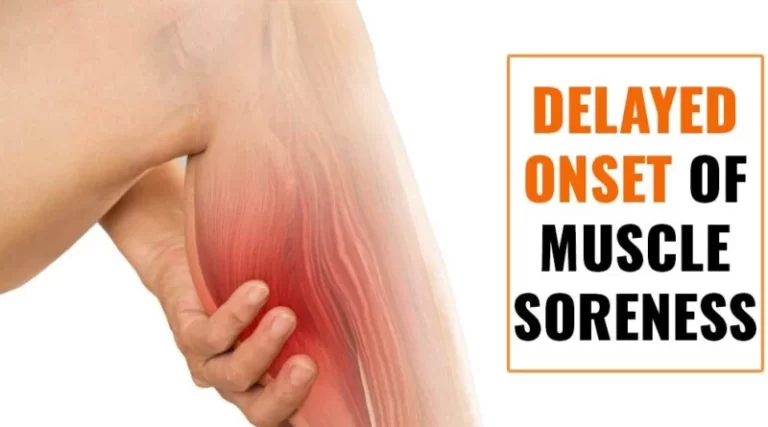
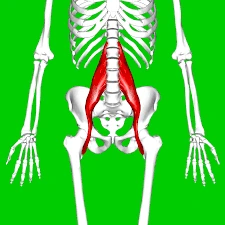
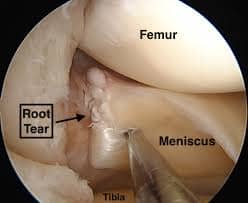

One Comment